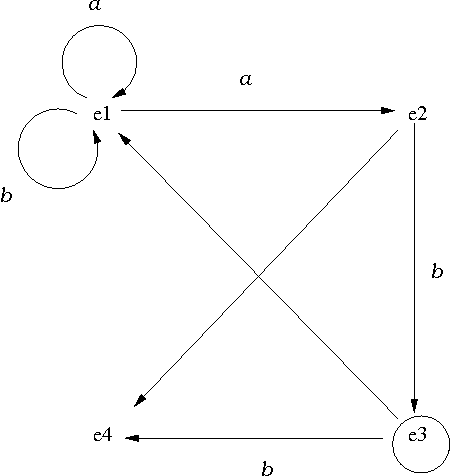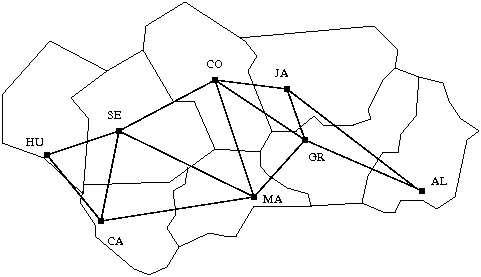
inversa(+L1,-L2), reverse(L1,L2), se verifica si L2 es la lista inversa de L1. Por ejemplo,?- inversa([a,b,c],L).
L = [c, b, a] inversa con append (no recursiva final):inversa_1([],[]).
inversa_1([X|L1],L2) :-
inversa_1(L1,L3),
append(L3,[X],L2).inversa con acumuladores (recursiva final):inversa_2(L1,L2) :-
inversa_2_aux(L1,[],L2).
inversa_2_aux([],L,L).
inversa_2_aux([X|L],Acum,L2) :-
inversa_2_aux(L,[X|Acum],L2).?- findall(_N,between(1,1000,_N),_L1),
time(inversa_1(_L1,_)), time(inversa_2(_L1,_)).
501,501 inferences in 0.40 seconds
1,002 inferences in 0.00 seconds
?- findall(_N,between(1,2000,_N),_L1),
time(inversa_1(_L1,_)), time(inversa_2(_L1,_)).
2,003,001 inferences in 1.59 seconds
2,002 inferences in 0.00 seconds
?- findall(_N,between(1,4000,_N),_L1),
time(inversa_1(_L1,_)), time(inversa_2(_L1,_)).
8,006,001 inferences in 8.07 seconds
4,002 inferences in 0.02 secondsCombinaciones
combinacion(+L1,+N,-L2) se verifica si L2 es una combinación N-aria de L1. Por ejemplo,?- combinacion([a,b,c],2,L).
L = [a, b] ; L = [a, c] ; L = [b, c] ; Nocombinacion_1(L1,N,L2) :-
subconjunto(L2,L1),
length(L2,N).
combinacion_2(L1,N,L2) :-
length(L2,N),
subconjunto(L2,L1).
combinacion(L1,N,L2) :-
combinacion_2(L1,N,L2).combinaciones(+L1,+N,-L2) se verifica si L2 es la lista de las combinaciones N-arias de L1. Por ejemplo,?- combinaciones([a,b,c],2,L).
L = [[a, b], [a, c], [b, c]]combinaciones_1(L1,N,L2) :-
findall(L,combinacion_1(L1,N,L),L2).
combinaciones_2(L1,N,L2) :-
findall(L,combinacion_2(L1,N,L),L2).
combinaciones(L1,N,L2) :-
combinaciones_2(L1,N,L2).?- findall(_N,between(1,6,_N),_L1),
time(combinaciones_1(_L1,2,_L2)),
time(combinaciones_2(_L1,2,_L2)).
429 inferences in 0.00 seconds
92 inferences in 0.00 seconds
?- findall(_N,between(1,12,_N),_L1),
time(combinaciones_1(_L1,2,_L2)),
time(combinaciones_2(_L1,2,_L2)).
28,551 inferences in 0.01 seconds
457 inferences in 0.00 seconds
?- findall(_N,between(1,24,_N),_L1),
time(combinaciones_1(_L1,2,_L2)),
time(combinaciones_2(_L1,2,_L2)).
117,439,971 inferences in 57.59 seconds
2,915 inferences in 0.00 secondsPermutaciones
select(?X,?L1,?L2) se verifica si X es un elemento de la lista L1 y L2 es la lista de los restantes elementos. Por ejemplo,?- select(X,[a,b,c],L).
X = a L = [b, c] ;
X = b L = [a, c] ;
X = c L = [a, b] ;
No
?- select(a,L,[b,c]).
L = [a, b, c] ;
L = [b, a, c] ;
L = [b, c, a] ;
Nopermutacion(+L1,-L2) se verifica si L2 es una permutación de L1. Por ejemplo,?- permutacion([a,b,c],L).
L = [a, b, c] ; L = [a, c, b] ;
L = [b, a, c] ; L = [b, c, a] ;
L = [c, a, b] ; L = [c, b, a] ;
Nopermutacion([],[]).
permutacion(L1,[X|L2]) :-
select(X,L1,L3),
permutacion(L3,L2).permutation.Variaciones
variacion(+L1,+N,-L2) se verifica si L2 es una variación N-aria de L1. Por ejemplo,?- variacion([a,b,c],2,L).
L=[a,b];L=[a,c];L=[b,a];L=[b,c];L=[c,a];L=[c,b];Novariacion_1(L1,N,L2) :-
combinacion(L1,N,L3), permutacion(L3,L2).
variacion_2(_,0,[]).
variacion_2(L1,N,[X|L2]) :-
N > 0, M is N-1,
select(X,L1,L3),
variacion_2(L3,M,L2).
variacion(L1,N,L2) :- variacion_2(L1,N,L2).variaciones(+L1,+N,-L2) se verifica si L2 es la lista de las variaciones N-arias de L1. Por ejemplo,?- variaciones([a,b,c],2,L).
L = [[a,b],[a,c],[b,a],[b,c],[c,a],[c,b]]variaciones_1(L1,N,L2) :-
setof(L,variacion_1(L1,N,L),L2).
variaciones_2(L1,N,L2) :-
setof(L,variacion_2(L1,N,L),L2).
variaciones(L1,N,L2) :-
variaciones_2(L1,N,L2).?- findall(N,between(1,100,N),L1),
time(variaciones_1(L1,2,L2)),
time(variaciones_2(L1,2,L2)).
221,320 inferences in 0.27 seconds
40,119 inferences in 0.11 seconds
?- findall(N,between(1,200,N),L1),
time(variaciones_1(L1,2,L2)),
time(variaciones_2(L1,2,L2)).
1,552,620 inferences in 2.62 seconds
160,219 inferences in 0.67 seconds
?- findall(N,between(1,400,N),L1),
time(variaciones_1(L1,2,L2)),
time(variaciones_2(L1,2,L2)).
11,545,220 inferences in 19.02 seconds
640,419 inferences in 2.51 secondsOrdenación por generación y prueba
ordenacion(+L1,-L2) se verifica si L2 es la lista obtenida ordenando la lista L1 en orden creciente. Por ejemplo,?- ordenacion([2,1,a,2,b,3],L).
L = [a,b,1,2,2,3]ordenacion(L,L1) :-
permutacion(L,L1),
ordenada(L1).
ordenada([]).
ordenada([_]).
ordenada([X,Y|L]) :-
X @=< Y,
ordenada([Y|L]).Ordenación por selección
ordenacion_por_seleccion(L1,[X|L2]) :-
selecciona_menor(X,L1,L3),
ordenacion_por_seleccion(L3,L2).
ordenacion_por_seleccion([],[]).
selecciona_menor(X,L1,L2) :-
select(X,L1,L2),
not((member(Y,L2), Y @< X)).Ordenación por divide y vencerás
ordenacion_rapida([],[]).
ordenacion_rapida([X|R],Ordenada) :-
divide(X,R,Menores,Mayores),
ordenacion_rapida(Menores,Menores_ord),
ordenacion_rapida(Mayores,Mayores_ord),
append(Menores_ord,[X|Mayores_ord],Ordenada).
divide(_,[],[],[]).
divide(X,[Y|R],[Y|Menores],Mayores) :-
Y @< X, !,
divide(X,R,Menores,Mayores).
divide(X,[Y|R],Menores,[Y|Mayores]) :-
\% Y @>= X,
divide(X,R,Menores,Mayores).Ordenación: comparación de eficiencia
Comparación de la ordenación de la lista [N,N-1,N-2,...,2,1]
| N | `ordena` | `selección` | `rápida` |
|-----+--------------------+------------------------+--------------------+
| 1 | 5 inf 0.00 s | 8 inf 0.00 s | 5 inf 0.00 s |
| 2 | 10 inf 0.00 s | 19 inf 0.00 s | 12 inf 0.00 s |
| 4 | 80 inf 0.00 s | 67 inf 0.00 s | 35 inf 0.00 s |
| 8 | 507,674 inf 0.33 s | 323 inf 0.00 s | 117 inf 0.00 s |
| 16 | | 1,923 inf 0.00 s | 425 inf 0.00 s |
| 32 | | 13,059 inf 0.01 s | 1,617 inf 0.00 s |
| 64 | | 95,747 inf 0.05 s | 6,305 inf 0.00 s |
| 128 | | 732,163 inf 0.40 s | 24,897 inf 0.01 s |
| 256 | | 5,724,163 inf 2.95 s | 98,945 inf 0.05 s |
| 512 | | 45,264,899 inf 22.80 s | 394,497 inf 0.49 s |Cuadrado mágico por generación y prueba
Enunciado: Colocar los números 1,2,3,4,5,6,7,8,9 en un cuadrado 3x3 de forma que todas las líneas (filas, columnas y diagonales) sumen igual.
A B C D E F G H I
cuadrado_1([A,B,C,D,E,F,G,H,I]) :-
permutacion([1,2,3,4,5,6,7,8,9],
[A,B,C,D,E,F,G,H,I]),
A+B+C =:= 15, D+E+F =:= 15,
G+H+I =:= 15, A+D+G =:= 15,
B+E+H =:= 15, C+F+I =:= 15,
A+E+I =:= 15, C+E+G =:= 15.?- cuadrado_1(L).
L = [6, 1, 8, 7, 5, 3, 2, 9, 4] ;
L = [8, 1, 6, 3, 5, 7, 4, 9, 2]
Yes
?- findall(_X,cuadrado_1(_X),_L),length(_L,N).
N = 8
YesCuadrado mágico por comprobaciones parciales
cuadrado_2([A,B,C,D,E,F,G,H,I]) :-
select(A,[1,2,3,4,5,6,7,8,9],L1),
select(B,L1,L2),
select(C,L2,L3), A+B+C =:= 15,
select(D,L3,L4),
select(G,L4,L5), A+D+G =:= 15,
select(E,L5,L6), C+E+G =:= 15,
select(I,L6,L7), A+E+I =:= 15,
select(F,L7,[H]), C+F+I =:= 15, D+E+F =:= 15. ?- cuadrado_2(L).
L = [2, 7, 6, 9, 5, 1, 4, 3, 8] ;
L = [2, 9, 4, 7, 5, 3, 6, 1, 8]
Yes?- setof(_X,cuadrado_1(_X),_L),
setof(_X,cuadrado_2(_X),_L).
YesComparación de eficiencia del cuadrado mágico
?- time(cuadrado_1(_X)).
161,691 inferences in 0.58 seconds
?- time(cuadrado_2(_X)).
1,097 inferences in 0.01 seconds
?- time(setof(_X,cuadrado_1(_X),_L)).
812,417 inferences in 2.90 seconds
?- time(setof(_X,cuadrado_2(_X),_L)).
7,169 inferences in 0.02 secondsEjemplo de autómata no determinista (con estado final e3)

Representación de un autómata (automata.pl)
final(E) se verifica si E es el estado final.final(e3).trans(E1,X,E2) se verifica si se puede pasar del estado E1 al estado E2 usando la letra X.trans(e1,a,e1). trans(e1,a,e2). trans(e1,b,e1).
trans(e2,b,e3).
trans(e3,b,e4).nulo(E1,E2)se verifica si se puede pasar del estado E1 al estado E2 mediante un movimiento nulo.nulo(e2,e4).
nulo(e3,e1).Simulación de los autómatas no deterministas
acepta(E,L) se verifica si el autómata, a partir del estado E acepta la lista L. Por ejemplo,acepta(e1,[a,a,a,b]) => Sí
acepta(e2,[a,a,a,b]) => Noacepta(E,[]) :-
final(E).
acepta(E,[X|L]) :-
trans(E,X,E1),
acepta(E1,L).
acepta(E,L) :-
nulo(E,E1),
acepta(E1,L).Consultas al autómata
[a,a,a,b]?- acepta(e1,[a,a,a,b]).
Yes[a,b]?- acepta(E,[a,b]).
E=e1 ;
E=e3 ;
Noe1?- acepta(e1,[X,Y,Z]).
X = a Y = a Z = b ;
X = b Y = a Z = b ;
NoGrafo de Andalucía

Representación del grafo
arcos(+L) se verifica si L es la lista de arcos del grafo.arcos([huelva-sevilla, huelva-cadiz,
cadiz-sevilla, sevilla-malaga,
sevilla-cordoba, cordoba-malaga,
cordoba-granada, cordoba-jaen,
jaen-granada, jaén-almeria,
granada-almeria]).Adyacencia y nodos
adyacente(?X,?Y) se verifica si X e Y son adyacentes.adyacente(X,Y) :-
arcos(L),
(member(X-Y,L) ; member(Y-X,L)).nodos(?L) se verifica si L es la lista de nodos.nodos(L) :-
setof(X,Y^adyacente(X,Y),L).Caminos
camino(+A,+Z,-C) se verifica si C es un camino en el grafo desde el nodo A al Z. Por ejemplo,?- camino(sevilla,granada,C).
C = [sevilla, córdoba, granada] ;
C = [sevilla, málaga, córdoba, granada]
Yescamino(A,Z,C) :-
camino_aux(A,[Z],C).camino_aux(+A,+CP,-C) se verifica si C es una camino en el grafo compuesto de un camino desde A hasta el primer elemento del camino parcial CP (con nodos distintos a los de CP) junto CP.camino_aux(A,[A|C1],[A|C1]).
camino_aux(A,[Y|C1],C) :-
adyacente(X,Y),
not(member(X,[Y|C1])),
camino_aux(A,[X,Y|C1],C).hamiltoniano(-C) se verifica si C es un camino hamiltoniano en el grafo (es decir, es un camino en el grafo que pasa por todos sus nodos una vez). Por ejemplo,?- hamiltoniano(C).
C = [almería, jaén, granada, córdoba, málaga, sevilla, huelva, cádiz]
?- findall(_C,hamiltoniano(_C),_L), length(_L,N).
N = 16 hamiltonianohamiltoniano_1(C) :-
camino(_,_,C),
nodos(L),
length(L,N),
length(C,N). hamiltonianohamiltoniano_2(C) :-
nodos(L),
length(L,N),
length(C,N),
camino(_,_,C). ?- time(findall(_C,hamiltoniano_1(_C),_L)).
37,033 inferences in 0.03 seconds (1234433 Lips)
?- time(findall(_C,hamiltoniano_2(_C),_L)).
13,030 inferences in 0.01 seconds (1303000 Lips)